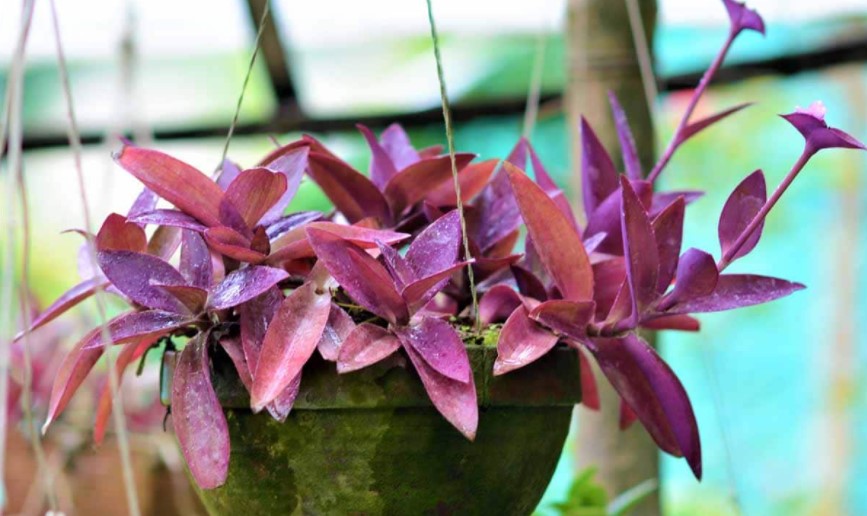“Purple Heart” Plant also known as the Tradescantia Pallida plant is a beautiful indoor plant that has a royal purple-colored stem and the upper surface of the leaves. Mostly the plant is grown as an indoor plant due to its unique but attractive foliage and blooms with beautiful pink to purple colored flowers throughout the warm season. The plant belongs to the spiderwort family and is native to the Gulf Coast region of Mexico.

The plant is very commonly used as a hanging plant, as a groundcover due to its aggressive spread, and as well in outdoor or terrace gardens. This gorgeous perennial plant has elongated, pointed leaves that have a shade of turquoise-grey and violet. Originally named as the Setcreasea pallida, in 1911 this plant was again classified into genus Tradescantia in 1975 by Royal Botanic Garden Kew. This striking plant will definitely uplift the whole look of your garden or room if you care and keep the plant alive in good favorable conditions.
Purple Heart Plant Care
- Purple heart plant light requirements: Unlike many plants, the plant is good when it comes to tolerating the heat of the direct sun. Plant them in full light to see the vibrant purple stems. But the plant prospers in partial shade as well but the color of the leaves is more likely to be green. However, too much direct sunlight might tear the leaves or burn the foliage.
- Purple heart plant water requirements: A matured purple heart plant is known to be drought-tolerant and can survive in fewer watering sessions. For the best growth of the plant, do not let the upper surface of the soil be dry and water it when it feels dry to touch. However, a small plant requires more water sessions during the growing period and it must be watered weekly especially in the blooming time.
- Purple heart plant soil requirements: The plant needs a lightweight and moist soil that is well-drained. The potting mixes available in the market are perfect for the plant or you can make your own mix by adding perlite, moss, and compost. Make sure that you put the soil in a container and make drainage holes at the bottom to let the water drain away to avoid root rot.
- Purple heart plant temperature requirements: The plant can survive the normal winters but keep the temperature above 10 degrees celsius to avoid damage to the plant. An ideal temperature between 19 to 26 degrees celsius is considered the best for optimal growth. Medium to low humidity is perfect for plants and avoid high humidity to avoid root rot. Average humidity in the household is good for growth and in drier conditions you can use a humidifier to maintain a decent amount of humidity around the plant.
Propagation of Purple Heart Plant

The propagation process to grow new plants from an existing healthy plant is quite simple. You just need to make sure that you are using scissors, the knife, or shears that are cleaned before using to avoid infections. The whole process can be taken out in two different ways mentioned below:
- Purple heart plant propagation in Soil: Cut the growing node of the stem and during morning or evening and put it in a soil mix. The roots tend to grow from those nodes only, maintain the required atmosphere near the plant, and water it to keep the surface moist all the time. Gradually after some weeks, roots will start growing.
- Purple heart plant propagation in Water: Another way of developing roots is by cutting the growing node of the plant. After some weeks you will see roots growing from the tips of the plant. After developing roots, you can simply plant them into a small container and put them under optimal conditions.
Also read: China doll plant
Benefits of Purple Heart Plant
- Used as a medicinal plant: The Ayta community has shown that purple heart plant medicinal uses as well and one such is that it helps in curing sore eyes. Along with that, the Taiwanese people said that it has good anti-inflammatory and antitoxic properties. The plant is even good to improve the circulation in your body and has antibacterial properties.
- Removes toxins from the air: Studies have been made and concluded that the plant is good at removing the volatile organic compounds from the air that cause respiratory problems. The plant promotes a healthy environment by purifying the air and helps you to focus on your work and it is one of the biggest purple heart plant benefits. Even the smallest pollutants or hazardous compounds get purified if you have this plant at your home.
Conclusion
The purple heart plant is a beautiful ornamental plant that can be grown quite easily at your homes if you take adequate care of watering, light, soil, and temperature requirements. The plant has some attractive benefits as well. People who keep on asking whether purple heart plants are poisonous to humans or pets, well, there are no such evident cases right now that show if it is poisonous or not. However, there are reports that it may cause skin issues, allergies, and redness when it comes to direct contact. But to be on the safer side keep it away from your pets and children at home. There are no such problems related to pests and diseases, but sometimes it may attract caterpillars and snails when grown outdoors.
FAQs:
Q1: Can Purple Heart plants grow indoors?
Often grown as a groundcover plant, now this plant is commonly used houseplant everywhere and grows well in optimal conditions.
Q2: Is Purple Heart Plant poisonous to dogs?
Although they may be good at some point, the plant could be dangerous to dogs and other pets if ingested.
Q3: Will Purple Heart root in water?
Yes, the plant roots well in water. Just place the growing nod in a small water container until it starts to root.
